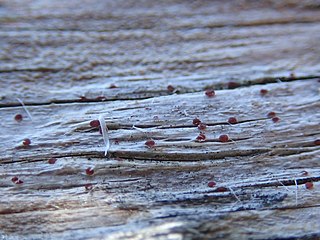
Agyrium is a genus of saprophytic fungi in the family Agyriaceae. It probably evolved from a lichen ancestor, as it is closely related to many lichenized species of fungi.
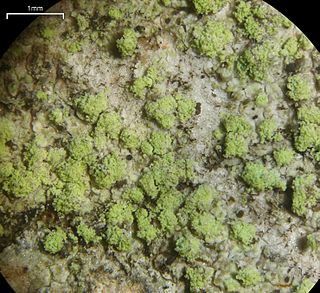
Biatora is a genus of lichens in the family Ramalinaceae. First described in 1817, the genus consists of crustose and squamulose lichens with green algal photobionts, biatorine apothecia, colorless, simple to 3-septate ascospores, and bacilliform pycnospores. According to the Dictionary of the Fungi, the genus contains 42 species that are widely distributed in temperate areas.

Lecania is a genus of lichenized fungi in the family Ramalinaceae. The genus was circumscribed by Abramo Bartolommeo Massalongo in 1853. Lecania is widely distributed, especially in temperate regions, and contains about 64 species.

Acarospora is a genus of mostly lichen-forming fungi in the family Acarosporaceae. Most species in the genus are crustose lichens that grow on rocks in open and arid places all over the world. They may look like a cobblestone road or cracked up old paint, and are commonly called cobblestone lichens or cracked lichens. They usually grow on rock, but some grow on soil (terricolous) or on other lichens. Some species in the genus are fungi that live as parasites on other lichens. Acarospora is a widely distributed genus, with about 128 species according to a 2008 estimate.

Micarea is a genus of lichenized fungi in the family Pilocarpaceae. The widely distributed genus contains 126 species and new species are described actively. Species in the genus are crustose lichens and their photobiont is a single-celled green alga.
Lophium is a genus of fungi in the family Mytilinidiaceae. It was described by Swedish mycologist Elias Magnus Fries in 1818.
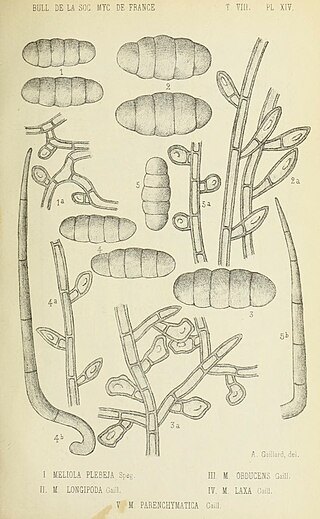
Meliola is a large genus of fungi in the family Meliolaceae. It was circumscribed by Swedish mycologist Elias Magnus Fries in 1825.
Leciophysma is a genus of cyanolichens in the family Pannariaceae. It has four species. The genus was circumscribed by Theodor Magnus Fries in 1865, with Leciophysma finmarkicum assigned as the type species.

Rhizocarpon is a genus of crustose, saxicolous, lecideoid lichens in the family Rhizocarpaceae. The genus is common in arctic-alpine environments, but also occurs throughout temperate, subtropical, and even tropical regions. They are commonly known as map lichens because of the prothallus forming border-like bands between colonies in some species, like the common map lichen.

Pilophorus acicularis, commonly known as the nail lichen or the devil's matchstick lichen, is a species of matchstick lichen in the family Cladoniaceae.

Lobothallia is a genus of lichens in the family Megasporaceae. Species in the genus have foliose thalli that become crustose areolate in the center with age, and grow on calcareous to siliceous rocks. The crustose part of the body may keep its lower cortex, though not always. Dark brown to black apothecia may be sunken into the surface of the thallus, as indicated in the common name puffed sunken disk lichen. Members grow to 3–5 cm (1.2–2.0 in) or more radiating lobes (placodioid). The photobiont is green alga from the genus Trebouxia. The genus is represented in Eurasia, Asia, North Africa, Central America, western North America, and Australia.

Arthrorhaphis is a genus of lichen-forming fungi in the monotypic family Arthrorhaphidaceae. It has 13 species. The genus was circumscribed by Theodor Magnus Fries in 1860. The family was proposed by lichenologists Josef Poelt and Josef Hafellner in 1976. Species in this family have a widespread distribution in temperate and montane habitats. They grow symbiotically with green algae, or parasitically on other lichens. The family Arthrorhaphidaceae has an uncertain taxonomic placement in the class Lecanoromycetes; that is, it is incertae sedis with respect to ordinal placement.
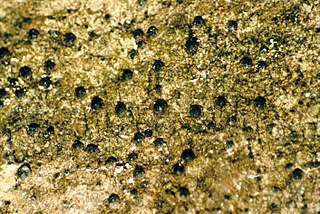
Scoliciosporum is a genus of lichens in the family Scoliciosporaceae.

Schaereria is a genus of lichen-forming fungi. It is the sole genus in the family Schaereriaceae, which itself is the only family in the Schaereriales, an order in the subclass Ostropomycetidae of the class Lecanoromycetes. Most Schaereria species are crustose lichens that live on rocks. Schaereria was first proposed by Gustav Wilhelm Körber in 1855 and was later taken up by other lichenologists despite periods of disuse.

Lambiella is a genus of lichen-forming fungi in the family Xylographaceae. The genus was circumscribed by German botanist Hannes Hertel in 1984, with Lambiella psephota assigned as the type species.
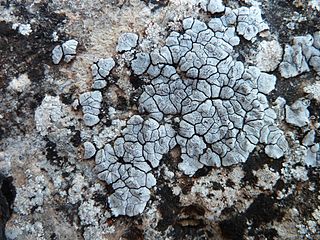
Placocarpus schaereri is a species of saxicolous (rock-dwelling), areolate, and crustose lichen in the family Verrucariaceae. Found in Europe, it is the type species of genus Placocarpus. The lichen was first described scientifically in 1831 by Elias Magnus Fries, who called it Parmelia schaereri. The species epithet honours Swiss pastor and lichenologist Ludwig Schaerer. Othmar Breuss transferred it to the newly reinstated genus Placocarpus in 1985.
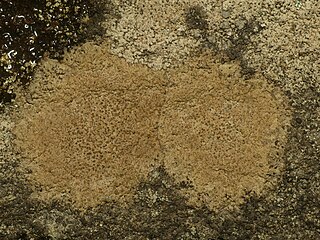
Ionaspis is a genus of lichen-forming fungi in the family Hymeneliaceae. It contains six species of saxicolous (rock-dwelling), crustose lichens. The genus was originally circumscribed in 1871 by Theodor Magnus Fries. He segregated the genus from Aspicilia based on the presence of Trentepohlia rather than Trebouxia as the photobiont partner.















